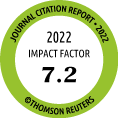|
Objective: To
determine which
common risk factors,
including
environmental
factors, are
predictors for the
development of
asthma in Cuban
schoolchildren.
Methods: A
longitudinal study
was conducted in
1042 schoolchildren
without asthma at
baseline in 2 Cuban
municipalities.
Asthma status in
2007, diagnosed
using the
International Study
of Asthma and
Allergies in
Childhood
questionnaire, was
related to a set of
common risk factors
assessed in
2003/2004 in a
multivariable
logistic regression
model. Multiple
imputation was used
for missing values.
The final prediction
model was obtained
by backward
selection (P<.15).
The models
prognostic accuracy
(R2) and
discriminative
ability (area under
the receiver
operating
characteristic curve
[AUC]) were assessed
and internal
validation by
bootstrapping was
performed.
Results: A
family history of
atopic diseases
(odds ratio [OR],
2.19; 95% CI,
1.19-4.04), allergic
sensitization (OR,
1.83; 95% CI,
0.94-3.55),
municipality (OR,
0.34; 95% CI,
0.15-0.74), and use
of antibiotics in
the childs first
year of life (OR,
1.66; 95% CI,
0.89-3.11) were
predictors for
asthma development.
The model had an R2
of 8.0% and a
moderate
discriminative
ability (AUC, 0.69;
95% CI, 0.60-0.78).
Internal validation
hardly influenced
the models
performance.
Conclusions:
Antibiotics use,
genetic
predisposition, and
allergic
sensitization were
predictors of asthma
in Cuban
schoolchildren.
Although known as
common risk factors
they could only
partly predict
asthma development.
Poverty-related
factors, such as low
income and
education, and
parasitic
infections, did not
have an effect.
Other or additional
environmental
predictors need to
be identified, as
these are potential
targets for
prevention and
control of childhood
asthma in affluent
as well as
nonaffluent
countries.
Key words:
Asthma. Cuba.
Prediction model.
Predictors. Risk
factors.
Schoolchildren. |



